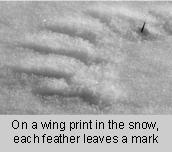Animal tracks abound in all of this snow! Snow is advantageous to many active animals in Vermont’s winter landscape, though as it gains depth rapidly with the series of storms we’ve had this month, it will slow down movement for larger animals such as white tailed deer. But smaller animals will burrow safely in its insulating depth to move from food cache to nesting sites, gaining protection from predators and from more serious cold in the air above.
 Around our Nature Center we saw a beautiful pattern of small rodent tracks, perhaps belonging to a white footed mouse or deer mouse, making a large figure eight around our white pine trees. The children attending our morning Preschool Discovery Program were fascinated with the tracks that ended in a one inch hole, and they bent closely to see what they might spot down below. However, when we followed a separate set of tracks in the same area, those tracks ended more ominously at a hand sized depression flanked by light strokes of wing feathers. Clearly, a predatory bird had found a meal. We didn’t see any of this happen, we could only read the story in the tracks. So, as you venture out on skis or snowshoes, watch for tales unfolding in the snow. Wild animals have to move a lot to find energy to survive at this time of year, but we can read that message of movement from knowing basic track patterns. Keep your eyes on the snow!
Around our Nature Center we saw a beautiful pattern of small rodent tracks, perhaps belonging to a white footed mouse or deer mouse, making a large figure eight around our white pine trees. The children attending our morning Preschool Discovery Program were fascinated with the tracks that ended in a one inch hole, and they bent closely to see what they might spot down below. However, when we followed a separate set of tracks in the same area, those tracks ended more ominously at a hand sized depression flanked by light strokes of wing feathers. Clearly, a predatory bird had found a meal. We didn’t see any of this happen, we could only read the story in the tracks. So, as you venture out on skis or snowshoes, watch for tales unfolding in the snow. Wild animals have to move a lot to find energy to survive at this time of year, but we can read that message of movement from knowing basic track patterns. Keep your eyes on the snow!
 Around our Nature Center we saw a beautiful pattern of small rodent tracks, perhaps belonging to a white footed mouse or deer mouse, making a large figure eight around our white pine trees. The children attending our morning Preschool Discovery Program were fascinated with the tracks that ended in a one inch hole, and they bent closely to see what they might spot down below. However, when we followed a separate set of tracks in the same area, those tracks ended more ominously at a hand sized depression flanked by light strokes of wing feathers. Clearly, a predatory bird had found a meal. We didn’t see any of this happen, we could only read the story in the tracks. So, as you venture out on skis or snowshoes, watch for tales unfolding in the snow. Wild animals have to move a lot to find energy to survive at this time of year, but we can read that message of movement from knowing basic track patterns. Keep your eyes on the snow!
Around our Nature Center we saw a beautiful pattern of small rodent tracks, perhaps belonging to a white footed mouse or deer mouse, making a large figure eight around our white pine trees. The children attending our morning Preschool Discovery Program were fascinated with the tracks that ended in a one inch hole, and they bent closely to see what they might spot down below. However, when we followed a separate set of tracks in the same area, those tracks ended more ominously at a hand sized depression flanked by light strokes of wing feathers. Clearly, a predatory bird had found a meal. We didn’t see any of this happen, we could only read the story in the tracks. So, as you venture out on skis or snowshoes, watch for tales unfolding in the snow. Wild animals have to move a lot to find energy to survive at this time of year, but we can read that message of movement from knowing basic track patterns. Keep your eyes on the snow!
No comments:
Post a Comment